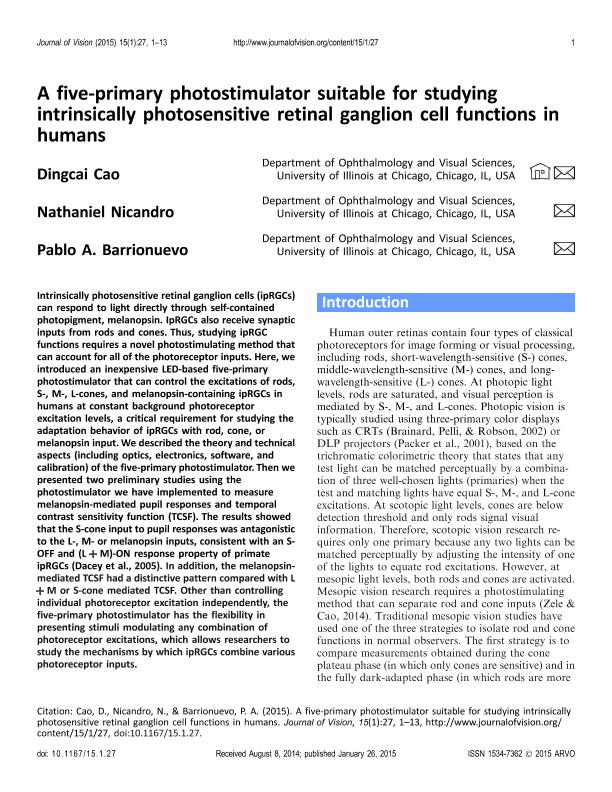Mostrar el registro sencillo del ítem
dc.contributor.author
Cao, Dingcai
dc.contributor.author
Nicandro, Nathaniel
dc.contributor.author
Barrionuevo, Pablo Alejandro

dc.date.available
2016-12-29T18:21:55Z
dc.date.issued
2015-01
dc.identifier.citation
Cao, Dingcai; Nicandro, Nathaniel; Barrionuevo, Pablo Alejandro; A five-Primary photostimulator suitable for studying intrinsically photosensitive retinal ganglion cell functions in humans; Association for Research in Vision and Ophthalmology; Journal of Vision; 15; 27; 1-2015; 1-13
dc.identifier.issn
1534-7362
dc.identifier.uri
http://hdl.handle.net/11336/10617
dc.description.abstract
Intrinsically photosensitive retinal ganglion cells (ipRGCs) can respond to light directly through self-contained photopigment, melanopsin. IpRGCs also receive inputs from rods and cones. Thus, studying ipRGC functions requires a novel photostimulating method that can account for all of the photoreceptor inputs. Here, we introduce an inexpensive LED-based five-primary photostimulator that can control the excitations of rods, S-, M-, L-cones and melanopsin-containing ipRGCs in humans at constant background photoreceptor excitation levels, a critical requirement for studying the adaptation behavior of ipRGCs with rod, cone or melanopsin input. We describe the theory and technical aspects (including optics, electronics, software and calibration) of the five-primary photostimulator. Then we present two preliminary studies using the photostimulator we have implemented to measure melanopsin-mediated pupil responses and temporal contrast sensitivity function (TCSF). The results showed that the S-cone input to pupil responses was antagonistic to the L-, M- or melanopsin inputs, consistent with an S-OFF and (L+M)-ON response property of primate ipRGCs (Dacey et al., 2005). In addition, the melanopsin-mediated TCSF had a distinctive pattern compared with L+M or S-cone mediated TCSF. Other than control individual photoreceptor excitation independently, the five-primary photostimulator has the flexibility in presenting stimuli modulating any combination of photoreceptor excitations, which allows to study the mechanisms by which ipRGCs combine various photoreceptor inputs.
dc.format
application/pdf
dc.language.iso
eng
dc.publisher
Association for Research in Vision and Ophthalmology
dc.rights
info:eu-repo/semantics/openAccess
dc.rights.uri
https://creativecommons.org/licenses/by-nc-sa/2.5/ar/
dc.subject
Five-Primary
dc.subject
Photoreceptors
dc.subject
Melanopsin
dc.subject.classification
Óptica

dc.subject.classification
Ciencias Físicas

dc.subject.classification
CIENCIAS NATURALES Y EXACTAS

dc.subject.classification
Otras Ingeniería Médica

dc.subject.classification
Ingeniería Médica

dc.subject.classification
INGENIERÍAS Y TECNOLOGÍAS

dc.title
A five-Primary photostimulator suitable for studying intrinsically photosensitive retinal ganglion cell functions in humans
dc.type
info:eu-repo/semantics/article
dc.type
info:ar-repo/semantics/artículo
dc.type
info:eu-repo/semantics/publishedVersion
dc.date.updated
2016-12-28T16:31:10Z
dc.journal.volume
15
dc.journal.number
27
dc.journal.pagination
1-13
dc.journal.pais
Estados Unidos

dc.journal.ciudad
Maryland
dc.description.fil
Fil: Cao, Dingcai. University Of Illinois; Estados Unidos
dc.description.fil
Fil: Nicandro, Nathaniel. University Of Illinois; Estados Unidos
dc.description.fil
Fil: Barrionuevo, Pablo Alejandro. University Of Illinois; Estados Unidos. Consejo Nacional de Investigaciones Científicas y Técnicas; Argentina
dc.journal.title
Journal of Vision

dc.relation.alternativeid
info:eu-repo/semantics/altIdentifier/url/http://jov.arvojournals.org/article.aspx?articleid=2213232
dc.relation.alternativeid
info:eu-repo/semantics/altIdentifier/doi/http:/dx.doi.org/10.1167/15.1.27
Archivos asociados
